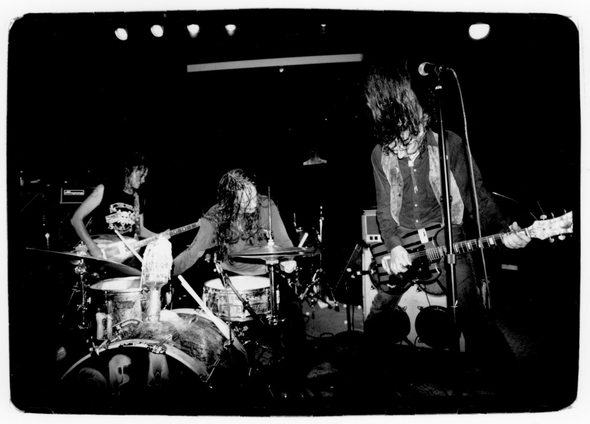“Groundhog Day” is a real pile driver. The first track off of the new Corin Tucker Band LP, Kill My Blues, it’s the perfect context setter coming from the ex-frontwoman of a legendary riot grrrl band, nearing forty. Tucker paints herself as a “Rip Van Winkle in a denim mini skirt” who “took some time to be a mom” and is now distressed that the place of women hasn’t advanced: “We fight the same battle, over and over again.”
What really matters is that the song is two and a half minutes of concentrated, powerful rock. The message is heartfelt, without feeling obligatory. But it might have made better sense on Tucker’s first post-Sleater-Kinney album, 1,000 Years, which is where she re-introduced herself to her audience. In the title track to that album, Tucker sang that she “stood frozen” as “the deepest silence stole my song”, but that she now felt “alive after 1,000 years.”
1,000 Years was, by the standards of Sleater-Kinney, a relatively low-key affair. It was also low-key compared to Wild Flag, who were playing their first concerts around the time of the Tucker release. Featuring Tucker’s S-K compatriots Carrie Brownstein and Janet Weiss, Wild Flag felt and sounded more like Sleater-Kinney than did The Corin Tucker Band. They were loud, always threatening to careen out of control. In Brownstein, they had the most charismatic of the S-K alums. You could attend a Wild Flag show and almost imagine you were seeing Sleater-Kinney with the legendary Mary Timony (Helium, Autoclave) sitting in.
Often, the elephants in the room are unfair. It’s understandable that Tucker would be compared to her former band. However, comparisons to Wild Flag should have led nowhere. The two bands are not in competition. And Tucker deserves credit for following a muse markedly different from the band that made her famous.
Which leads to Kill My Blues. I’m reminded of “Middle of the Road” by the Pretenders, when Chrissie Hynde sings, “I’m not the cat I used to be, I’ve got a kid, I’m thirty-three.” Tucker is 39, which is getting on in years for a rocker, particularly women facing the stereotypically sexist double standards held for older female artists. Tucker has been singing eloquently about being a mother since “Sympathy” with Sleater-Kinney ten years ago, but it’s not the subject matter of her songs that matters as much as the persona “Corin Tucker.” Fans still want an element of authenticity from their stars, but it’s possible that outside of the fervent fan base of a cult figure, Tucker-as-wife-and-mom is a kind of authenticity that isn’t easily accepted.
In Kill My Blues, the Portland singer ups the wattage, and the good reviews. Legendary indie critic Robert Christgau, and Pitchfork offer a mix of both qualified and positive endorsements, suggesting that fans are glad that she’s made a noisier record than 1,000 Years. Certainly, Kill My Blues more effectively grabs the listener. There’s an air of reassurance, that’s key to persuading listeners to take this second record more seriously than the first.
Identifying with Corin Tucker’s adulthood is key. If 1,000 Years was her way of saying hello again, and explaining where she’d been, Kill My Blues assumes we all know that tale, and it moves forward from there. Both are “mature” albums, but Kill My Blues doesn’t draw attention to that aspect. It makes a curiously interesting companion piece to the new Pink album, The Truth About Love: both singers are now moms, both have to deal with the stereotypes that implies, and both manage to blend the adult nature of their current lives with the youthful feel of rock rebellion in exciting ways.
Of course, there’s Tucker’s voice, still one the great instruments in rock and roll. Her vocals, like the album as a whole, are more controlled than ever. While there has always been a thrill in hearing Tucker let fly (going all the way back to the early days of Sleater-Kinney in songs like “Call the Doctor”) she picks her moments now. The music is the better for it, even if thrill junkies like me, who miss Sleater-Kinney, wish it were otherwise. Still, Corin Tucker hasn’t lost her feel for the roar.
One of the highlights of the album is “Neskowin” (Neskowin Beach is a recreation site on the Oregon coast). It’s a simple narrative of two 13-year-old girls taking a family vacation to Neskowin, and how they find a way to get a different kind of fun when they sneak into town. Much of the power comes from Tucker’s wailing vocals, alongside ex-Unwound drummer Sara Lund’s background “Woo Woo Woo!” It’s not really a story about rebellion. Rather, it’s about how young people begin to find out who they are by taking small steps towards rebellion. “Lacquered up our tightest jeans, testing out our looks, hit the arcade, the pizza place, so much to see, so much to taste.”
The video for “Neskowin” offers an interesting extension of this theme. It’s 1983, and the family is going on vacation. Tucker plays the Mom. Her teenage daughter fakes a stomach ache so she can stay home, and once the family leaves, she gets together with her friend. They dance in the bedroom to punk rock (X-Ray Spex seem to be a favorite,) get dressed up, and head into town. On the way, they are picked up by a van of hippies (Tucker is one of the hippies) who take them to downtown. They end up in a club, where X-Ray Spex are playing. The Corin Tucker Band plays the legendary punks; Tucker is dressed and made up like Poly Styrene. The girl ends up on stage, a raucous time is had by all, and as the song and video end, she is asleep in her own bed, where Corin-the-Mom tucks her in.
It’s fascinating to see how Tucker fits into the video. She is long past the time when she would play the teenager. Instead, she plays various women who impact on the teenager’s life: the caring, if “square”, mother; the acidhead hippie who gets the girl downtown; and the punk rocker who inspires the girl. The mother creates the girl, the hippie gets her started on her journey, Poly Styrene serves as a role model, and it all returns to mom tucking her in. It’s a concise version of what Corin Tucker has done in her career, and in her life. She helped create vital, important music, showing the way to those who followed her, while always recognizing her own roots.
Live, the band exhibits many of the same strengths found on the album. Sara Lund handles everything thrown her way with aplomb, adding helpful background vocals as well. Bass player Mike Clark (also in Steven Malkmus’ band The Jicks, with S-K’s Janet Weiss) is important by his very existence: it’s nice to see a bass player in a band again. (I once interviewed Tucker and her bandmates in Cadallaca, for the late Punk Planet. When I asked why they didn’t have a bass player, I got quizzical looks, as if it should be obvious why no one wanted to be the bass player.)
Lund and Clark give a solid bottom that’s welcomed. Guitarist and keyboard player Seth Lorinczi (ex-Circus Lupus) also adds depth to the sound of the band, although after seeing the band twice, I have to say that during the songs, Lorinczi is almost Miles Davis-esque in his lack of attention to the audience, at times playing with his back to us. He’s also more personable between songs, and, in fairness, Seth Lorinczi may just be deflecting the spotlight towards Tucker.
The Corin Tucker Band’s strengths, though, do take away a certain edge that Tucker’s earlier band displayed. They remind me a bit of David Johansen’s first post-New York Dolls group. Johansen’s band were “better” musicians than the Dolls, but “better” was never the point of Johnny Thunders. There isn’t a feeling of danger here. While it’s easy to see why that can be a good thing, and how it fits into where Tucker is today, there is a reason why the New York Dolls are legends while David Johansen is just a talented solo artist.
Corin Tucker is the key, in any case. To state the most obvious fact, she’s the leader of the band. This is not a meeting of equals, no matter how tight their music has become. It was impossible to imagine Sleater-Kinney without all three participants. The only indispensable member of the Corin Tucker Band is Corin Tucker. She doesn’t grab the stage the way her old bandmate Carrie Brownstein does, and there’s a noticeable and appealing lack of self-indulgence in her performance. That carries over, however, into her vocals.
As noted earlier, Tucker deliberately parcels out her vocal pyrotechnics now, though the audience would be happy if she cut loose a bit more often in that regard. (At a recent gig at San Francisco’s Cafe Du Nord, some of the best audience response came when Tucker gave us a hot vocal.) Even with all of her talents, Corin Tucker’s voice remains the most remarkable thing in her arsenal.
It’s pointless to criticize Tucker for what she isn’t. It’s equally pointless, though, to pretend she doesn’t have a body of work behind her that we think of when we listen to her today. Kill My Blues may not fulfill the Sleater-Kinney nostalgia of her audience the way Wild Flag does. But that just might mean Tucker’s music takes the braver path.
Photograph courtesy of Chunky Glasses. Published under a Creative Commons license.





